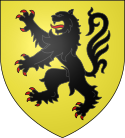
The Treaty of Athis-sur-Orge was a peace treaty signed on 23 June 1305 between King Philip IV of France and Robert III of Flanders.[1] The treaty was signed at Athis-sur-Orge after the Battle of Mons-en-Pévèle and concluded the Franco-Flemish War (1297-1305).
Despite winning the battle at Mons-en-Pévèle, Philip's kingdom was too financially and militarily drained to take advantage of it.[2] The treaty instead imposed a heavy price.[2]
Terms
The cities of Lille, Douai, and Orchies were allocated to the French crown.[3] In return, the treaty's terms allowed Flanders to preserve its independence with the Count of Flanders but as a fiefdom of France. At the same time, the treaty provided a yearly penalty of 20,000 pond and reparations of 400,000 pond paid by the Flemish.[2] They also were required to furnish Philip with 600 knights and to tear down the fortresses around large cities.[2] Bruges was mandated to send 3,000 individuals on pilgrimage, and 1,000 of them were required to travel overseas.[2]
Robert III of Flanders faced an impossible task of placating the French monarchy and trying to keep the Flemish cities from revolting.[2] It was not until after 1309 that some monetary reparations were paid.[4]
Uprisings
Because the financial terms of the treaty were so severe, it was met with wide disapproval in Flanders.[2] In June 1310, Pope Clement V, under pressure from Philip, stated that those who failed to fulfill the terms of the treaty would be excommunicated.[5] Aardenburg and Ghent suffered riots in 1311 during tax collection.[4] Flemish farmers and the middle class were hit the hardest, and the Peasant Revolt in Flanders broke out in 1323.[6]
The peasants' revolt turned into a popular uprising, which dominated politics for five years in Flanders. It was crushed in 1328 at the Battle of Cassel.
See also
References
- ^ Strickland 2010, p. 85.
- ^ a b c d e f g Kittell 1991, p. 109.
- ^ Sumption 1999, p. 185.
- ^ a b TeBrake 1993, p. 35.
- ^ Jordan 1995, p. 311.
- ^ Verbruggen 1997, p. 153.
Sources
- Jordan, William Chester (1995). "The Capetians from the death of Philip II to Philip IV". In Abulafia, David; Jones, Michael (eds.). The New Cambridge Medieval History. Vol. 5, c. 1198–c. 1300. Cambridge University Press.
- Kittell, Ellen E. (1991). From Ad Hoc to Routine: A Case Study in Medieval Bureaucracy. University of Pennsylvania Press.
- Strickland, Matthew (2010). "The Wars of Philip the Fair and his Successors, 1285–1328". In Rogers, Clifford J. (ed.). The Oxford Encyclopedia of Medieval Warfare and Military Technology. Vol. 2: East-Menf. Oxford University Press.
- Sumption, Jonathan (1999). The Hundred Years War. Vol. 1, Trial by Battle. University of Pennsylvania Press.
- TeBrake, William H. (1993). A Plague of Insurrection: Popular Politics and Peasant Revolt in Flanders, 1323–1328. University of Pennsylvania Press.
- Verbruggen, J. F. (1997). The Art of Warfare in Western Europe During the Middle Ages: From the Eighth Century to 1340. The Boydell Press.
